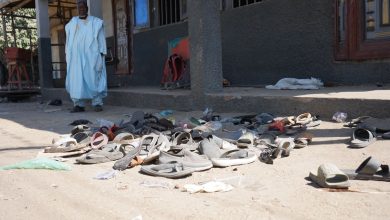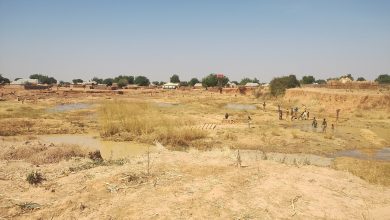In Adamawa, Swarms of Quelea Birds Ruin Rice Fields in Minutes
Rice farmers in parts of Adamawa State are grappling with a severe invasion of the quelea bird. While many have already suffered devastating losses, some spend their nights in the fields, warding off pests known for an insatiable appetite for rice seedlings.
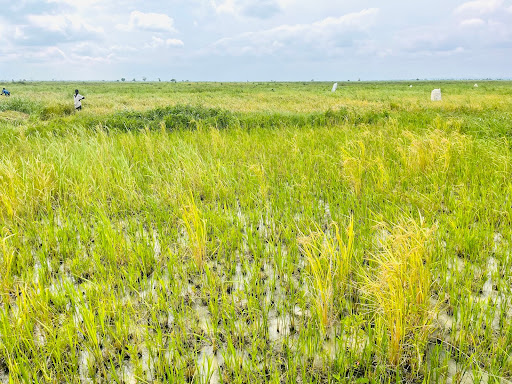
Mallam Abakar and his two sons leave their home in Gyawana, Lamurde Local Government Area of Adamawa State, northeastern Nigeria, at 5 a.m. every weekday. Thirty minutes later, they arrive at the farm, and each one of them takes a position.
Five-year-old Isiaka sits at the entrance, guarding a wide bed of ripening rice. His older brother, Abu, stays in the opposite direction. Their father settles near their makeshift shelter, his gaze sweeping across the entire field.
Isiaka and Abu clutch pieces of zinc and wooden sticks to make a sound. Day after day, the boys repeat this routine, standing guard over their father’s rice field as if it were a battlefield.
By 6 a.m., the team is on high alert. As the father patrols the edges of the field, the boys pound their gongs and shout fiercely, driving away swarms of quelea birds before they can descend.
The quelea species native to sub-Saharan Africa is the most numerous bird species in the world, with a peak post-breeding population estimated at 1.5 billion, according to the Centre for Agriculture and Bioscience International. Known as the red-billed quelea, this small weaver bird is notorious for its attacks on small-grain crops. It is a major pest throughout much of sub-Saharan Africa and can cause significant economic losses.

Across Nigeria, the recurring quela bird invasion of rice farms remains a great challenge to farmers, especially those in Adamawa, Taraba, Sokoto, Jigawa, and Yobe. The invasion is noted as one of the reasons driving food shortages in these regions, as the dangerous parasites are capable of wiping out hectares in minutes during every invasion.
The family that watches
Mallam Abakar has been cultivating rice for more than a decade. Apart from the recurring flood, farmer-herder clashes, another challenge he faces in the region is quelea bird invasions.
The first major invasion in Adamawa State was reported in 2016, when the birds swept through 12 council areas, destroying crops worth millions of naira. Since then, the birds have repeatedly unleashed large-scale devastation, pushing rice farmers in the region into crippling losses.
“The birds come every year. In the last few years, we noticed a decline in their invasions, but this year, they are back with full force,” Abakar said.
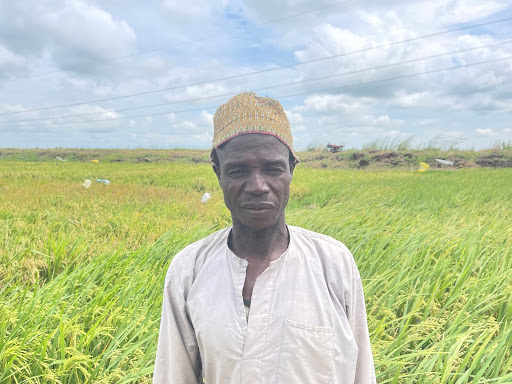
HumAngle gathered that the birds usually appear at the end of July and stay until October. As early as 6 a.m., they start hovering above the fields, attempting to descend, prompting farmers to chase them away in an effort to protect their crops.
The birds are scarcely seen in the afternoon, as they retreat to nearby sugar cane plantations for rest. However, around 5 p.m., they re-emerge in their thousands, and farmers resume their vigilant watch.
Local farmers say the birds are highly sensitive to sound, often targeting unguarded farms.
Flying in a swarm of thousands, they descend, settle, and can strip a hectare of rice in minutes. The birds are attracted to mostly rice fields, especially those nearing maturity. They feed by sucking out the milky sap from developing grains or plucking out fully ripened seeds. In addition to feeding damage, their rapid wingbeats shake the plants, causing seedlings and grains to fall to the ground.
To keep them away, the farmers patrol their farms, and since they can’t be everywhere at once, they set up dummies to create the illusion of a human presence. Sometimes they tie strips of leather or plastic across the farms. When the wind blows, the strips flutter and mimic movement, which discourages the birds from descending. Farmers also hit gongs to scare the swarms away or alert neighbouring farms that the birds are on the move.
Mallam Abakar said he and his children only rest when the birds leave the fields in the afternoon. The family has set up a small tent on the farm, where they take shelter from the scorching sun. There, they pray and share meals before returning to their watch.
Shaking his head repeatedly, Abakar told HumAngle, “It’s draining. Imagine doing this every day before harvest. We get tired, and sometimes it feels like we should just let them be.”
However, he cannot ignore the birds, as he is a full-time farmer who relies on his farm yields to cater for his family. In a good year, he usually harvests around 20 bags of rice or more. However, in recent times, he has endured repeated tussles with the birds.
“There was a certain year they wiped off my entire rice field,” Abakar recounted. “It was devastating, and since then, I’ve been on guard.”
It was after the birds wiped off his rice fields that he started bringing his children to the farm to assist in scaring the birds away.
“We don’t wait for them to attack before we start defending,” Abakar said.
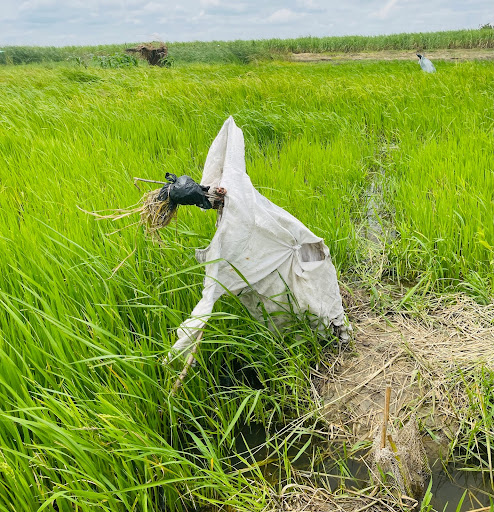
Tiny birds, huge losses
Bernard Ramson, a 40-year-old rice farmer in the region, who also works as a private security guard, told HumAngle that the quelea bird invasion on his farm left him depressed. He started farming in the region last year and enjoyed a bountiful harvest in April after taking part in irrigation.
“We started sighting the birds around July, and by August, their numbers tripled,” he said.
For months, Bernard tended to his rice farm, applying pesticides and weeding by hand. With less than a month to harvest, he was counting down until he arrived at his rice field one morning to find it destroyed. The birds had drained the milky sap from the ripening rice, leaving behind husks and wasted seeds.
“I was expecting over 20 bags of rice, but I ended up with half a bag. I was so disturbed to the extent that I was bedridden for days,” he said.
Bernard has not returned to the farm since the incident. He said the sight of the farm devastates him, and the loss has even disrupted his work routine, making him unable to cope.
He attributes the loss to his tight schedule. “Farmers who can’t wait all day hire people to watch their farms 24/7 and scare the birds away, but as a security guard who shuffles between work and farming, I wasn’t always available, so the birds took advantage of my absence and wreaked havoc on my farm,” Bernard said.
While they also damage guinea corn farms, he said, rice farmers suffer the most severe losses.
“I’ve seen people hitting gongs and walking around their farms. Others spread nets on the farm to trap the birds, but even that is not sufficient because some of them end up escaping from the net,” he said. While he is still grappling with the loss, he intends to resume farming next year, and this time, he said, he’d be prepared.
HumAngle spoke to some farmers in Garin Overseer, another community battling with the invasions in the Lamurde Local Government of Adamawa State.
Richard Pwanidi, a 35-year-old who inherited his father’s farmland, has erected a makeshift shelter on the farm. There, he and his brothers take turns warding off the quelea birds in the night. He had lost a significant portion of his rice crop to their invasion.
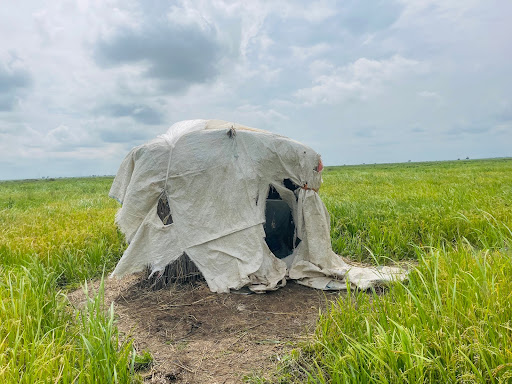
Richard said that though all mechanisms were in place to drive the birds away, the invasion had cost him a lot.
HumAngle observed leather strips tied around his farm, dummies placed in front of each rice bed, and his brothers constantly patrolling the fields, creating the impression of human movement. These strategies are similar to the ones adopted by other farmers in the area.
“We beat drums, we screamed when we saw them approaching, but it seems they were already used to it, because despite the effort, they flew into my farm, descended, and did their thing,” Richard said.
He lost three beds of rice to the birds, as did his brother on the same day.
Richard is currently carrying out an early harvest due to the invasion. Even though his rice crops require a week or more to fully ripen, he said he’d rather harvest them now than lose everything to the birds.
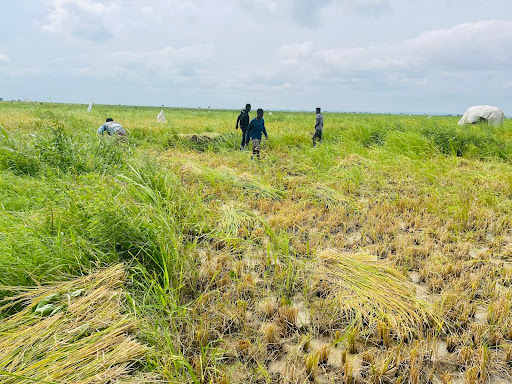
According to Richard, farmers in the region are tired. “We are not talking about five or ten thousand of them. We are talking about thirty thousand and above, descending at once,” he said.
‘Overlapping schedules’
After witnessing the devastation, HumAngle consulted Bethel Clement, a conservation biology scholar at the A.P. Leventis Ornithological Research Institute, University of Jos, Plateau State, on why the invasion persists. “The issue continues because farming schedules overlap with Quelea migration. Altering rice production timing to avoid this overlap could drastically reduce damage, though local constraints such as water availability may limit such flexibility,” he said.
The conservation biologist also said that while chemical spraying is widely used, it harms ecosystems and is unsustainable. He recommended more integrated measures, including synchronised planting and early harvesting, organised community bird-scaring, habitat management to reduce roosting near farms, and encouraging natural predators such as kestrels and owls through nest boxes and perches. These approaches, he said, balance food security with environmental protection and offer farmers long-term resilience.
‘We need help’
In 2020, the sum of ₦13 billion was approved by the Federal Government to tackle the quelea bird and other pest invasions across 12 affected states in Nigeria, including Adamawa, Bauchi, Borno, Kebbi, Sokoto, and Taraba. Four years later, the Federal Ministry of Agriculture and Rural Development flagged off the project in Kebbi. However, the affected farmers in Adamawa who spoke to HumAngle said they have yet to benefit from the intervention.
“I’ve been farming rice in this region with my late father since I was a boy, and I’ve never witnessed any aerial spray of chemicals facilitated by the government. We heard that money was approved by the government for aerial spraying, but we’ve not seen it so far,” Richard said.
He added that the only support they received was from Savannah Sugar, a private company that sprayed chemicals around farms in Gyawana, Garin Overseer, Opalo, and other areas, approximately ten years ago. “[After the company spread the chemical, the birds vanished for like three years before they returned,” Richard added.
HumAngle contacted the office of the Adamawa State Commissioner for Agriculture and Rural Development for comments on the state government’s planned response to the invasion, if any, but received no reply at press time.
Richard believes government intervention could prevent further losses.
“We need help,” the farmer said.
Support Our Journalism
There are millions of ordinary people affected by conflict in Africa whose stories are missing in the mainstream media. HumAngle is determined to tell those challenging and under-reported stories, hoping that the people impacted by these conflicts will find the safety and security they deserve.
To ensure that we continue to provide public service coverage, we have a small favour to ask you. We want you to be part of our journalistic endeavour by contributing a token to us.
Your donation will further promote a robust, free, and independent media.
Donate HereStay Closer To The Stories That Matter


